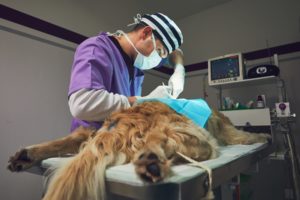
For your pet not to feel any discomfort or move during a procedure, anesthesia is necessary.
“Anesthesia” is probably a familiar term to you if you’ve ever had any dental work done. For your pet not to feel any discomfort or move during a procedure, anesthesia is necessary. Examples, where a pet may need anesthesia, include dentistry, surgery, and some diagnostic imaging. Today we’re going to discuss pre-operative procedures, the way we administer anesthesia, and how we monitor pets’ oxygen levels, carbon dioxide levels, along with other critical processes. The safety of your fur babies matters so much to us, and we want nothing more than to give our clients peace of mind.
Pre-Op Exam
The physical examination includes inspecting your pet’s entire body to ensure that any surgical procedure is safe to perform. We examine the body’s outer surface, mouth, ears, and eyes. Then we palpate the abdomen to feel for any abnormalities in the internal abdominal organs. We also listen to your pet’s heart and lungs with a stethoscope.
Pre-Anesthetic Bloodwork
Pre-anesthetic bloodwork consists of two blood test types, a Packed Cell Volume (PCV)(measures the proportion of red blood cells in the blood to check for dehydration or anemia) and a Blood Chemistry test (evaluates the liver, kidney, and glucose levels). Also, if a pet has had bleeding problems in the past and will be undergoing surgery, a coagulation test (measure’s the blood’s ability to clot) may be necessary. Pre-anesthetic bloodwork is vital because it can help us identify any problems that may not be evident during the physical examination. If there are abnormal test results, we will take particular precautions during surgery or reschedule it entirely.
Anesthesia, IV Catheter, and Fluids
Your pet will receive pain medication prior to their procedure. We will then give anesthesia via injection. We administer fluids to your pet throughout their procedure. The anesthesia injection and IV (intravenous) fluids require the placement of a catheter into a vein. These sterile fluids containing electrolytes go directly into the patient’s bloodstream. Administering IV fluids has many benefits, one being that these fluids help keep your pet’s blood pressure above critical levels during the surgical procedure and another is maintaining your pet’s hydration.
Multiparameter Monitoring, Ventilators, and Analgesia (Pain Management)
Multiparameter monitors check a pet’s EKG, oxygen and carbon dioxide levels, blood pressure, and temperature simultaneously. A multiparameter monitor is crucial to have during a surgical procedure because it detects irregular heart rates, respiratory issues, and more. We place an endotracheal tube into the mouth so that it threads down into the airway. This allows us to attach your pet to oxygen and the gas anesthesia that keep them sedated for the surgery. We also have ventilators available to ensure patients breathe throughout the surgery. Finally, post-surgery, we recommend FDA-approved pain medication that ensures your pet’s comfortability at home.
If your pet ever needs surgery, know that they are in good hands at MCAH. For more information on our surgical procedures, be sure to give us a call.
Here at Mount Carmel Animal Hospital, We’ll Treat Your Pets Like Family!
Mount Carmel Animal Hospital has been serving the Northern Baltimore/Southern York community for over 30 years and is proud to be an independently operated, small animal practice committed to excellence in veterinary medicine and client service. From grooming to wellness services, along with Canine Life Skills Training Courses, and surgical procedures, we have the expertise that will best serve the needs of you and your pet. Contact us at 410-343-0200 and follow us on Facebook!
